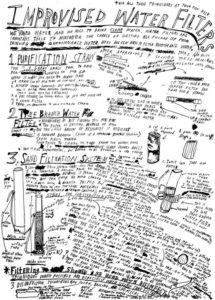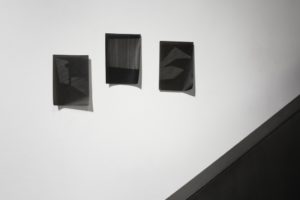Exhibition | In Case of Emergency & Homo Ludens (Man At Play)
Our exhibition correspondent Leonie Connellan takes us through two Dublin exhibitions: In Case of Emergency at the Science Gallery and Homo Ludens (Man at Play) at the Library Project.
It’s really quite something to walk into a room and be faced with a wall of Doomsday Clocks. I first learned of this project through Alan Moore’s comic ‘Watchmen’, and have been abstractly obsessed with it for years since.
The Doomsday Clock project was started by the Bulletin of Atomic Scientists in 1947, when the time was set at seven minutes to midnight, and has served as their cover art since. The project exists as a gauge for the likelihood of global nuclear war, and over the last ten years it has also been used to explore how climate change and developing technologies could permanently harm humanity.
In their latest exhibition, ‘In Case of Emergency’, Science Gallery Dublin open with a wall of 22 clocks, tracking each change that has been made over the course of the Doomsday Clock project. When I walked through the doors I knew exactly what it was, and stood for several minutes just taking it in. Knowing about the project and reading about it in fiction is one thing, but being faced physically with that wall of clocks is something else, and as much as I never want to be a teenager ever again, I wished that I could travel back to 1991 and stay there forever, when the clock was set at its farthest range since its conception, 17 minutes to midnight.
This year it was moved forward to two and a half minutes.

It’s not all doom and gloom existential crises in the show though. While a lot of the subject matter is challenging and very serious, the curators at the Science Gallery have continued their excellence in producing a fun, interactive, instructional exhibition. There is a beautiful silk quilt hanging on the wall made by British artist Anna Dumitriu in collaboration with Kevin Cole, Nicola Fawcett and John Paul. It’s delicate and lovely and, when you get up close, you learn that it was sterilised prior to exhibition. It’s patches of silk were decorated by infectious drug-resistant bacteria like pneumonia, E. Coli and staphylococcus.
Another highlight from the show was the series of instructional survival ink drawings by Irish artist Colin Matthes, who spent a year living on the Atlantic coast of Ireland. Each day he would walk uphill ten miles in the snow to school, I mean, he would walk for an hour in the inclement weather to his studio, and this manifested itself in an ongoing series of absolutely charming drawings embracing the ingenuity of the human spirit titled ‘Essential Knowledge: Drawings Teaching Success in Challenging Situations’. I even learned how to purify water on the fly.
When you need an escape from the end of the world, the Science Gallery is running another small show upstairs in their Deloitte Gallery. ‘Sparks’ is an informational exhibition covering the DIY Science Revolution, and it tells the stories of everyday people who are embracing citizen science to make the world a better place. The Science Gallery is running a series of talks to complement Sparks called the Science Espresso. The first talk was from Mary McCarron, Dean of the Faculty of Health Sciences and Professor of Ageing and Intellectual Disability at the School of Nursing and Midwifery at Trinity College, speaking about the overwhelmingly positive impact of responsible research design in a local Irish study on ageing and intellectual disability.

Meanwhile, a short walk down the road a small, minimalist group exhibition called ‘Homo Ludens (Man at Play)’ is showing at the Black Church Print Studio in Temple Bar. The exhibition is curated by Róisín Bohan and features playful architecturally inspired pieces by Cará Donaghey, Isabel English, Margot Galvin, Daire O’Shea and Irene Whyte. It was a little hard to get a solid reading of the works at the jam packed opening, but there was still a sense of lightness and adventure in the work. ‘Lost in the Sauce’ and ‘Memeopocene’, the steel and polycarbonate cube-like sculptures by Daire O’Shea are simultaneously grounded and ethereal, capturing light and shadow in wonderful ways. They’re also pretty funny, which is something I welcome more and more in art. Another standout was the series of delicate carbon paper monoprints by Irene Whyte titled ‘Silent Grey’, made in response to the blueprints and physical spaces of the Black Church Print Studio.
‘In Case of Emergency’ runs until 11 February 2018 and ‘Sparks’ runs until 18 February at Science Gallery Dublin, Trinity College, Pearse St, Dublin 2. The Science Espresso talks will take place on Tuesday evenings throughout January and February 2018.
‘Homo Ludens (Man at Play)’ runs at the Black Church Print Studio Library Project Gallery, 4 Temple Bar, Dublin 2 until 27 January 2018.
